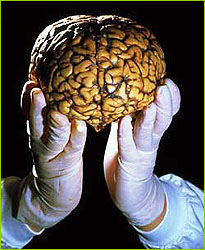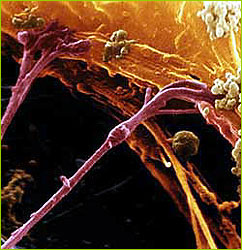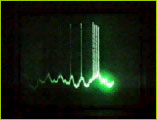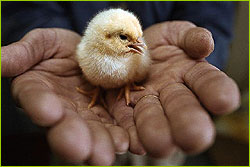|

|

|
|
|
 What is the nature of consciousness? Is it limited
to humans? Does free will exist? Read on for one
scientist's view.
What is the nature of consciousness? Is it limited
to humans? Does free will exist? Read on for one
scientist's view.
|
The Electric Brain
How does a three-pound mass of wet gray tissue (the brain)
succeed in representing the external world so beautifully?
In this interview with noted neuroscientist Rodolfo
Llinás of the New York University School of Medicine,
find out how the rhythm of electrical oscillations in the
brain gives rise to consciousness, and how failures in this
rhythm can lead to a variety of brain disorders.
NOVA: Let's start by talking about why one needs a
nervous system—or a brain—in the first place.
Llinás: That's a very intriguing issue. The
nervous system is about 550 million years old, and it first
came about when cells decided to make animals. Basically
there are two types of animals: animals, and animals that
have no brains; they are called plants. They don't need a
nervous system because they don't move actively, they don't
pull up their roots and run in a forest fire! Anything that
moves actively requires a nervous system; otherwise it would
come to a quick death.
NOVA: Why would it die if it didn't have a nervous
system?
Llinás: Because if you move, the variety of
environments that you find is very large. So if you happen
to be a plant you have to worry only about the very small
space you grow into. You don't have to do anything other
than maybe move up and down. And you're following the sun
anyhow, so there is no planned movement, and therefore there
is no necessity to predict
what is going to happen if, which is what the nervous
system seems to be about. It seems to be about moving in a
more or less intelligent way. The more elaborate the system,
the more intelligent the movement.
NOVA: So you need a nervous system in order to be
able to predict the future?
Llinás: Yes, and in order to predict you have
to have, at the very least, a simple image inside that tells
you something about the purpose of the outside world. That
is common to all nervous systems of all forms that we know
of. Each animal has a different universe—the universe
it sees, the universe it feels, the universe it tastes.
Earth probably looks very different not only for all of us
as individual humans, but also for different animals.
NOVA: How does consciousness come into this view of
the brain? Is consciousness a mysterious phenomenon, in your
opinion?
"We assume we have free will, but we don't."
|
|
Llinás: I don't think so. I think
consciousness is the sum of perceptions, which you must put
together as a single event. I seriously believe that
consciousness does not belong only to humans; it belongs to
probably all forms of life that have a nervous system. The
issue is the level of consciousness. Maybe in the
very primitive animals, in which cells did not have a single
systemic property—in which each cell was a little
island, if you wish—there may not have been
consciousness, just primitive sensation, or irritability,
and primitive movement. But as soon as cells talked to one
another there would be a consensus. This is basically what
consciousness is about—putting all this relevant stuff
there is outside one's head inside, making an image with it,
and deciding what to do. In order to make a decision you
have to have a consensus.
|
 This colored scanning electron micrograph shows the
synapses, or connections, between two nerve fibers
(in purple) and a nerve cell (yellow). The picture
is magnified 10,000 times.
This colored scanning electron micrograph shows the
synapses, or connections, between two nerve fibers
(in purple) and a nerve cell (yellow). The picture
is magnified 10,000 times.
|
NOVA: But it all just boils down to cells talking to
one another?
Llinás: Some people believe we are something
beyond neurons, but of course we are not. We are just the
sum total of the activity of neurons. We assume that we have
free will and that we make decisions, but we don't. Neurons
do. We decide that this sum total driving us is a decision
we have made for ourselves. But it is not.
NOVA: So this mass of wet gray tissue that is our
brain is made up of neurons?
Llinás: The brain is made out of cells. It is
a long and very distinguished group of cells—about 550
million years or so old. These cells have a small mass. Our
brain is about one-and-a-half liters, or three pounds, but
it has 1010 cells, which is
a huge number of cells. Ten billion cells. And each cell has
1,000 to 10,000 or so synapses—the connections between
the cells. So the brain has trillions of synapses.
NOVA: How does the brain keep all these different
neurons communicating in synch?
"Neurons like one another very much. They basically
chat all day."
|
|
Llinás: Neurons like one another very much.
They respond to one another's messages, so they basically
chat all day, like people do in society. "Where can I park?"
"How much is it going to cost?" "Am I going to get a
ticket?" One set of neurons talks to another set of neurons,
and they talk back, so we have a dialogue between different
components in the brain. And the dialogue is not between one
cell and another cell, but rather between many cells and
many other cells. It's like having a huge number of people
holding hands, dancing together, making ever-changing
circles and organized together in such a way that every cell
belongs, at some time, to some circle. It's like a huge
square dance. Each dancer belongs to a particular movement
at a particular time.
NOVA: And there's music that keeps them all dancing
together?
Llinás: Right. It's generated by the neurons
themselves. Neurons have an intrinsic rhythm, a bit like a
hum. They generate this electrical dance at a given
frequency because they have similar rhythms—they hum
in unison. But as in the case of choirs and dancing, you can
have two groups doing different things at the same time. Now
imagine that each group doing something represents an aspect
of an external event, like a color.
|
 Scientists have recorded the "hum" of neurons
communicating. This movie shows the response of
cells in the cortex to a visual stimulus.
Scientists have recorded the "hum" of neurons
communicating. This movie shows the response of
cells in the cortex to a visual stimulus.
View the video clip in:
QuickTime
| RealVideo:
56K/
ISDN+
Get video software:
QuickTime
|
RealVideo
|
NOVA: That's the brain's job—to represent an
external event?
Llinás: Right. Imagine many cells making an
activity circle, with electrical activity going around and
around like a windmill. Imagine that out of this circle come
a few cells into the center and perform a particular dance
that the other cells see but are not necessarily part of.
Now these cells that do this particular dance may be cells
that have learned something from the outside that they want
to put in the context of whatever else is happening in the
nervous system. The brain, when awake, is continually
generating a picture of the outside world. When new
information from the outside comes in it has to be put into
context with whatever else was happening just before.
NOVA: Is there ever nothing going on—no
dance—inside the brain?
Llinás: Sometimes there is nothing as far as
consciousness going on, like when you fall asleep. At that
time you are not generated. That particular dance, that is
you, is not being created by the brain at the moment. If you
are asleep but dreaming then the brain makes another dance
during which you exist but you don't care about the external
world. You can exist on your own with dreams,
hallucinations, or deep thoughts, or you can relate to the
outside world. Normal people want to relate to the outside
world. If you happen to be a schizophrenic you may not. You
may want to hallucinate somewhere in a corner. You are
consumed by your thoughts. You are fascinated by whatever is
inside your head.
NOVA: What part of the brain does this coordinating?
We've all heard of different areas. Frontal lobes do this,
another area does that....
Llinás: If we look at the nervous system there
are basically two functions. One is sensory—the
ability to respond to the outside world—and the other
is the ability to do something about it, the ability to
modify the world. As the nervous system gets more complex in
higher animals there's another totally astounding property,
which is the ability of the nervous system to invent things
inside the head, which it can then make into reality. All my
life, even as a child, I have been amazed that you can think
of something that doesn't exist and then by using the motor
system—painting, talking, constructing—you can
make them be part of the external world.
NOVA: Make a pie, for example.
The brain is the ultimate organ. It can make a
reality. It can dream it.
|
|
Llinás: Make a pie that didn't exist before.
So it gives you an idea of the unbelievable ability of the
system. Not only can it see or move, but it can also make a
reality. It can dream it. From that point of view, it really
is the ultimate organ. Each part of the brain has a
particular function with respect to the nervous system. The
visual cortex has one function, the frontal lobes have
another function, the auditory system has yet another
function. And yet when we look at the external world we see
things as having properties that are inseparable from the
object itself.
NOVA: Can you give us an example?
Llinás: Imagine I have a little bird on my
hand. I can see the bird. I can see its color. I can see its
shape. I can hear it sing. I can feel its weight on my hand.
It might peck me. All of these things occur simultaneously,
so we say that the bird has those properties. But all those
properties are put together in different parts of the brain.
So one wonders how the brain makes a collage of all these
sensory inputs to generate one single precept—the
bird—out of all the different sensory systems
activated. This is called the binding property. Since we
don't know for sure how it works, we call it the binding
problem.
|
 Our experience of a bird is made up of many
different sensory inputs, including color, sound,
smell, and touch. How does the brain put all this
information together simultaneously?
Our experience of a bird is made up of many
different sensory inputs, including color, sound,
smell, and touch. How does the brain put all this
information together simultaneously?
|
We are not sure exactly how it happens, but there are good
ideas about how it may happen. One of the ways we can
attempt to understand how it happens is by studying people
who have mental or neurological problems. Someone with a
lesion on his or her visual cortex would be able to hear and
feel and move but would not be able to see, so you know that
he or she injured the conscious component that sees but not
the other conscious components. So consciousness has parts.
Continue: How else can consciousness get damaged?
Visual Mind Games
|
From Ramachandran's Notebook
|
The Electric Brain
|
Probe the Brain
Resources
|
Teacher's Guide
|
Transcript
|
Site Map
|
Secrets of the Mind Home
Search |
Site Map
|
Previously Featured
|
Schedule
|
Feedback |
Teachers |
Shop
Join Us/E-Mail
| About NOVA |
Editor's Picks
|
Watch NOVAs online
|
To print
PBS Online |
NOVA Online |
WGBH
©
| Updated October 2001
|
|
|
|